15 Indiana Covered Bridges So Picture-Perfect They Belong On A Postcard
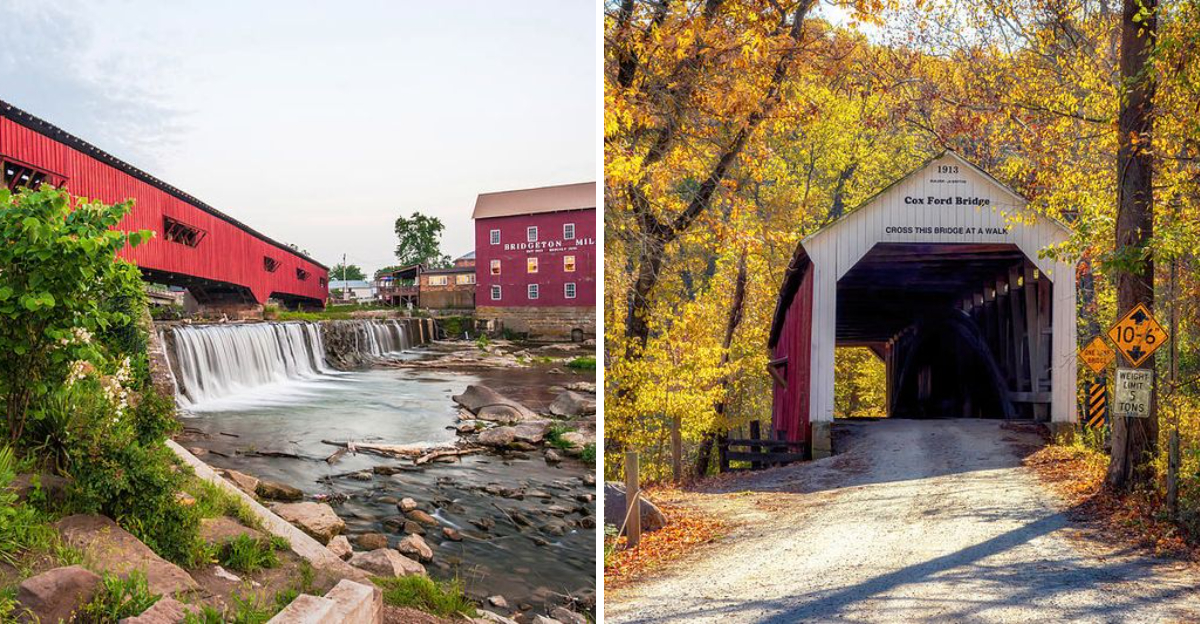
Timeless wooden trusses, sunlit creek crossings, and the soft echo of tires on old planks, few sights capture Americana quite like a covered bridge.
Across Indiana’s quiet backroads, these historic spans paint the landscape with charm and nostalgia, each one a window into the state’s 19th-century craftsmanship.
Some still carry cars, others invite slow strolls and photo ops, but all of them feel straight out of a storybook. Here are 15 Indiana covered bridges so picture-perfect they belong on a postcard.
1. Mansfield Covered Bridge
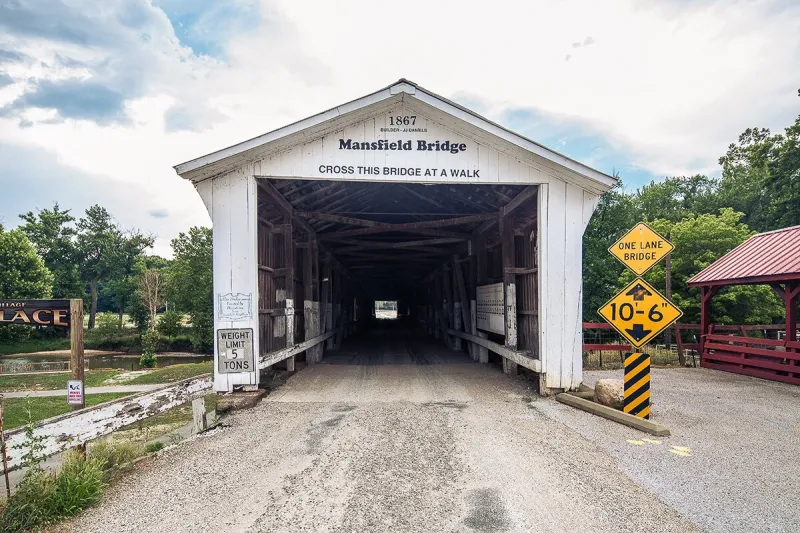
Stretching 247 feet across Big Raccoon Creek, Mansfield claims the title of Indiana’s longest covered bridge still standing. That’s longer than two basketball courts placed end-to-end, which is seriously impressive for a structure built in 1867.
Walking through feels like entering a wooden tunnel where sunlight filters through gaps in the weathered boards, creating dramatic shadows perfect for moody photography. The bridge’s length gives you plenty of angles to work with, whether you’re shooting from inside or capturing the full span from the creek bank.
Fishermen often cast lines nearby, adding authentic country charm to your visit.
2. Bridgeton Covered Bridge

Built back in 1868, this crimson beauty spans Mill Creek and stands as one of Indiana’s most photographed landmarks. The bright red paint practically glows against green summer leaves or fiery fall colors, making every season picture-worthy.
Nearby, you’ll find a charming mill that’s been converted into shops and eateries, perfect for grabbing lunch after your photo session. The whole area feels like you’ve time-traveled to simpler days when horses clip-clopped across wooden planks instead of cars.
Locals say this bridge has survived floods and fires, proving that good craftsmanship never goes out of style.
3. Cox Ford Covered Bridge

Nestled inside Turkey Run State Park, Cox Ford Bridge rewards hikers who venture down scenic trails with a stunning surprise. Originally constructed in 1913, this bridge serves as a gateway between towering trees and rushing water, blending seamlessly into the wilderness.
Unlike bridges sitting roadside, reaching this one requires a pleasant walk through nature, making your photos feel more adventurous and earned. The surrounding forest canopy creates dappled lighting that changes throughout the day, offering endless creative possibilities.
Pack your hiking boots and camera because this bridge won’t come to you—you’ve got to seek it out among the trees and trails.
4. Narrows Covered Bridge
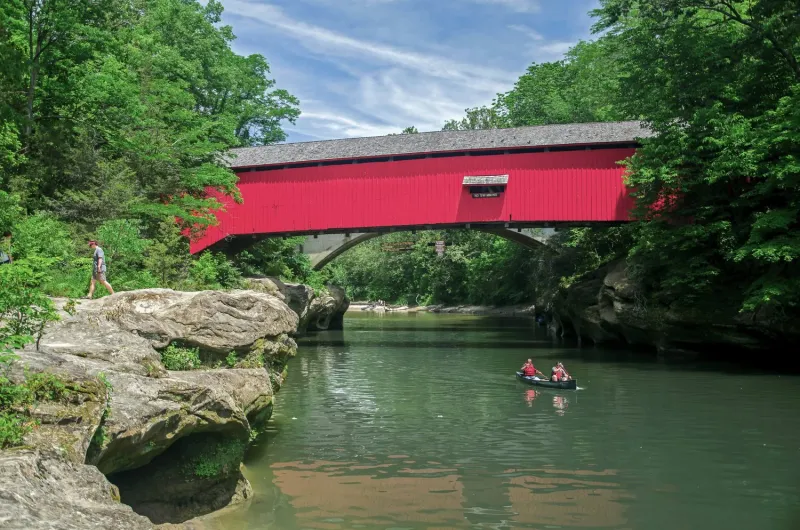
True to its name, Narrows squeezes across Sugar Creek with a slender profile that makes it look delicate despite being built tough back in 1882. The compact design creates an intimate feeling, like the bridge is whispering secrets from the past rather than shouting them.
Photographers love how the narrow structure frames the creek perfectly, creating natural leading lines that draw eyes straight through the tunnel. Morning mist rising from the water adds an ethereal quality that transforms ordinary snapshots into gallery-worthy prints.
Visit during golden hour when warm light bathes the weathered wood, and you’ll understand why artists keep returning here season after season.
5. Jackson Covered Bridge
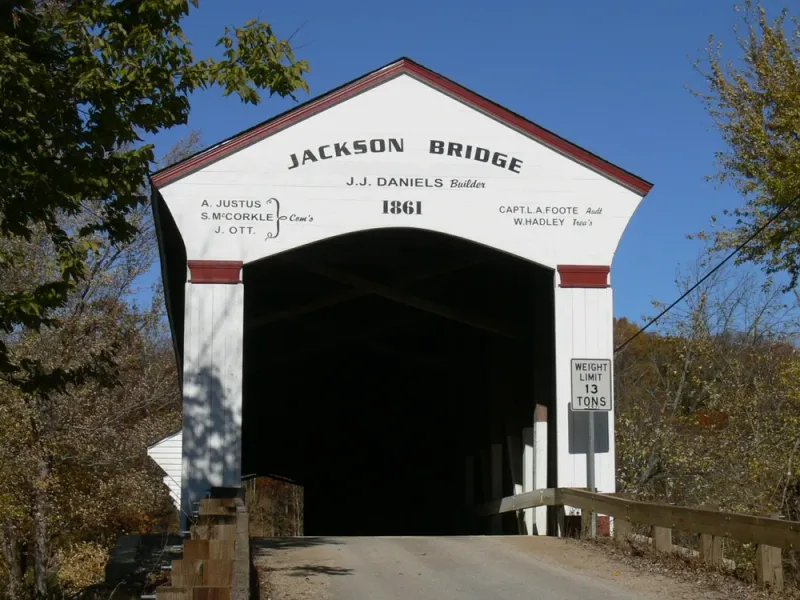
Breaking from the typical red barn aesthetic, Jackson sports a crisp white exterior that stands out like a pearl against green countryside. Constructed in 1861, it’s one of the older survivors, having witnessed the Civil War era and everything since.
The white paint reflects sunlight beautifully, creating bright, airy photos that feel lighter and more optimistic than darker bridges. Wildflowers often bloom along the banks below, adding splashes of color that complement rather than compete with the bridge’s clean appearance.
If you’re tired of every covered bridge looking identical, Jackson’s unique coloring offers refreshing variety for your postcard collection.
6. West Union Covered Bridge
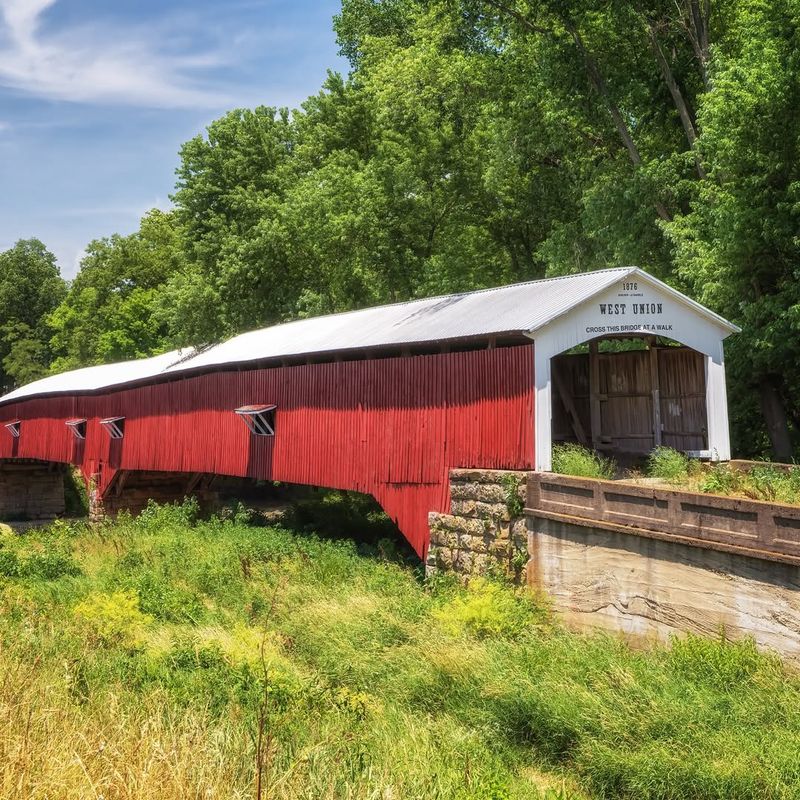
Engineers geek out over West Union’s burr arch truss design, but you don’t need a degree to appreciate how the graceful arches create elegant curves inside. Built in 1876, this architectural gem proves that practical engineering can also be downright gorgeous.
The bridge sits in a particularly photogenic spot where Sugar Creek bends gently, allowing photographers to capture reflections when water runs calm. Local legend claims couples who kiss while crossing will have good luck, though we can’t verify the success rate on that superstition.
Either way, the romantic setting makes it popular for engagement photos and anniversary celebrations throughout the year.
7. Billie Creek Covered Bridge

Part of a recreated pioneer village, Billie Creek Bridge comes with bonus attractions including historic buildings, working craftsmen, and seasonal festivals. The bridge itself dates to 1895 and was relocated here to become the centerpiece of this living history experience.
What makes this spot extra special is the complete old-timey atmosphere—you’re not just photographing a bridge, but an entire scene from yesteryear. Kids especially love exploring the village, which means parents can sneak in bridge photos while little ones stay entertained nearby.
During autumn festivals, the whole area buzzes with activity, creating lively backgrounds that tell bigger stories than a lonely bridge could manage alone.
8. Roseville Covered Bridge
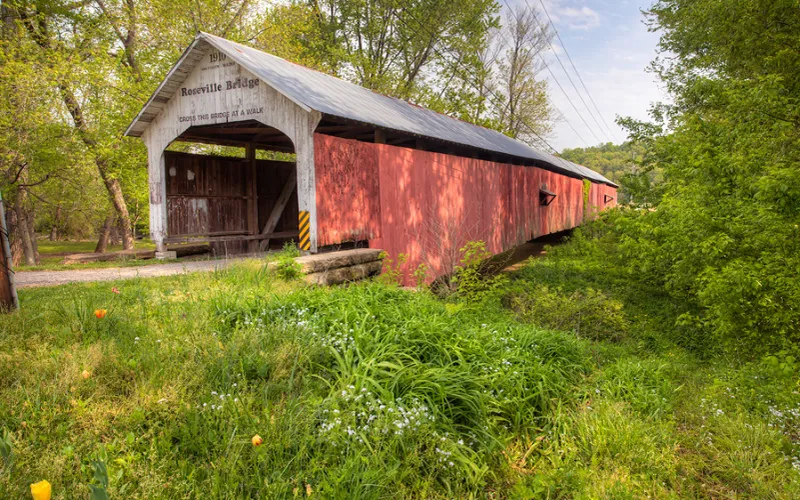
Roseville doesn’t try to be fancy or different—it just nails the classic covered bridge aesthetic with confident simplicity. Erected in 1910, it represents the tail end of the covered bridge era when builders had perfected their craft through decades of experience.
The straightforward red paint and clean lines make it almost archetypal, like the Platonic ideal of what every covered bridge should be. Sometimes simple is best, especially when you want photos that scream “authentic Indiana countryside” without any gimmicks or surprises.
Positioned near the town of Roseville, it’s easily accessible for visitors who want postcard perfection without hiking through wilderness or navigating confusing backroads first.
9. Medora Covered Bridge
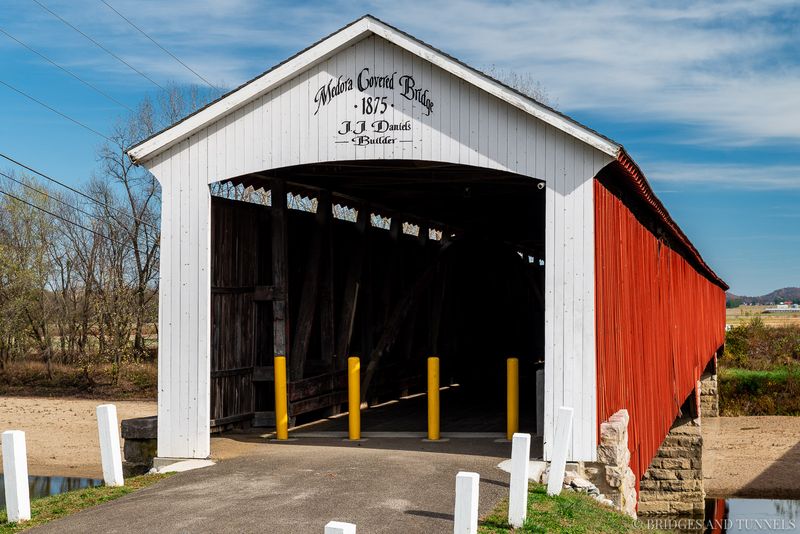
Down in southern Indiana, Medora stretches an impressive 431 feet across the East Fork White River, making it one of the longest covered bridges left standing anywhere. That’s almost one and a half football fields of wooden wonder, built way back in 1875 by skilled craftsmen who clearly didn’t believe in thinking small.
Walking through takes noticeably longer than shorter bridges, giving you time to appreciate the engineering feat and imagine horses pulling wagons through this same passage generations ago. The river below runs wider and deeper than most covered bridge creeks, adding grandeur to the whole scene.
Serious bridge enthusiasts make pilgrimages here specifically because of its remarkable length and historical significance.
10. Spencerville Covered Bridge

Up in northern Indiana where covered bridges are rarer, Spencerville stands as a proud exception to the region’s usual architecture. Constructed in 1873, it represents the northernmost examples of this distinctly Midwestern style, proving that good ideas spread beyond county lines.
The bridge’s location away from the major covered bridge clusters means fewer tourists and more peaceful photography sessions. You can take your time setting up shots without worrying about cars or crowds interrupting your creative process.
Locals treat it like their special secret, a hidden treasure that hasn’t been overrun by Instagram hordes hunting for the next viral post. Visit respectfully and you’ll understand the appeal.
11. Cataract Falls Covered Bridge

Pairing a covered bridge with Indiana’s largest waterfall creates a photographer’s dream combo that delivers double the scenic punch. The bridge itself charms with traditional styling, but the nearby cascading water elevates the whole experience from nice to unforgettable.
You can capture the bridge as your main subject, then walk downstream to shoot the falls, giving you two postcard-worthy locations within minutes of each other. The sound of rushing water adds sensory richness that makes visiting feel more immersive than just snapping quick pictures.
Families appreciate having multiple attractions clustered together, keeping everyone engaged instead of hearing complaints about visiting yet another boring old bridge nobody cares about except Mom.
12. Dick Huffman Covered Bridge
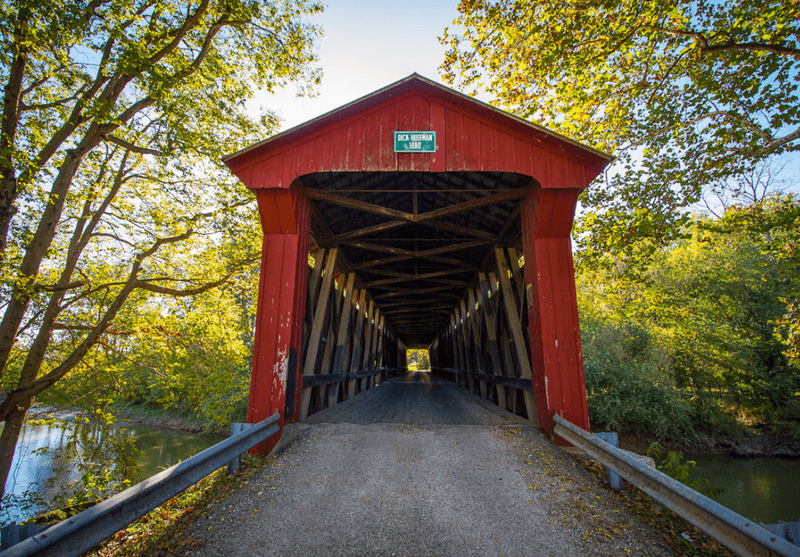
Named after a local bridge enthusiast who fought to preserve these structures, Dick Huffman Bridge honors the people who recognized covered bridges as cultural treasures worth saving. Built originally in the 1800s, it was restored and relocated to ensure future generations could appreciate its craftsmanship.
The preservation story adds emotional depth to your visit—you’re not just seeing old wood, but the result of community dedication and historical consciousness. Restoration work maintained authentic details while ensuring safety, striking that tricky balance between honoring the past and serving the present.
Every photograph you take here celebrates both the original builders and the modern heroes who refused to let history crumble into forgotten dust.
13. Baker’s Camp Covered Bridge

Tucked away where only determined explorers venture, Baker’s Camp rewards your navigation skills with solitude and unspoiled scenery. The bridge got its name from a nearby camping spot that once hosted travelers, back when crossing the creek meant planning your journey carefully.
Today’s visitors find the remoteness appealing rather than inconvenient, offering escape from crowded tourist spots and noisy modern life. The surrounding woods haven’t changed much in a century, creating an authentic time-capsule feeling that’s increasingly rare in our developed world.
Bring a picnic and spend an hour just soaking in the peaceful atmosphere that our ancestors knew as everyday normal but we now treasure as special.
14. Edna Collins Covered Bridge

Unlike bridges named for locations or builders, Edna Collins honors a real person whose story connects us to the human side of these structures. Learning about Edna—whoever she was and why she merited this tribute—adds personal dimension that transforms wood and nails into meaningful memorial.
The bridge itself features lovely proportions and classic styling that would photograph beautifully even without the interesting name. But knowing there’s a story behind it makes visitors pause longer, look closer, and appreciate the layers of history embedded in every beam.
Research Edna’s story before visiting, and you’ll find your photos carry deeper meaning than just another pretty bridge checked off your bucket list.
15. Houck Covered Bridge

Rounding out our postcard collection, Houck delivers everything you’d want in a classic covered bridge without trying too hard or showing off. Constructed in the late 1800s, it represents the golden age of covered bridge building when these structures dotted the countryside like red barns.
The surrounding farmland provides quintessentially Midwestern backdrops of rolling fields and scattered trees that frame the bridge perfectly from multiple angles. Seasons dramatically change the scenery here—spring green, summer gold, autumn fire, and winter white all create completely different moods around the same unchanging structure.
Visit multiple times throughout the year, and you’ll collect four distinctly different postcards from one reliable location that never disappoints.
